Rare Earth Ion Doped Luminescent Materials: A Review of Up/Down Conversion Luminescent Mechanism, Synthesis, and Anti-Counterfeiting Application
Abstract
:1. Introduction
2. Main Species of Rare Earth Luminescent Materials and Luminescent Mechanism
2.1. Upconversion Luminescence
2.2. Downconversion Luminescence
3. Luminescence Emission Regulation Pathway
3.1. Regulation of Local Crystal Fields
3.2. Structure Design
3.3. Dye Sensitized Upconversion
4. Synthetic Methods
5. Anti-Counterfeiting Application
6. Conclusions and Perspective
Author Contributions
Funding
Institutional Review Board Statement
Informed Consent Statement
Data Availability Statement
Conflicts of Interest
References
- Yan, C.L.; Zhao, H.G.; Perepichka, D.F.; Rosei, F. Lanthanide ion doped upconverting nanoparticles: Synthesis, structure and properties. Small 2016, 12, 3888–3907. [Google Scholar] [CrossRef] [PubMed]
- Zhang, H.X.; Chen, Z.H.; Liu, X.; Zhang, F. A mini-review on recent progress of new sensitizers for luminescence of lanthanide doped nanomaterials. Nano Res. 2020, 13, 1795–1809. [Google Scholar] [CrossRef]
- Sutter, J.P.; Béreau, V.; Jubault, V.; Bretosh, K.; Pichon, C.; Duhayon, C. Magnetic anisotropy of transition metal and lanthanide ions in pentagonal bipyramidal geometry. Chem. Soc. Rev. 2022, 51, 3280–3313. [Google Scholar] [CrossRef]
- Zhou, B.; Tao, L.L.; Chai, Y.; Lau, S.P.; Zhang, Q.Y.; Tsang, Y.H. Constructing interfacial energy transfer for photon up- and down-conversion from lanthanides in a core–shell nanostructure. Angew. Chem. Int. Ed. 2016, 55, 12356–12360. [Google Scholar] [CrossRef] [PubMed]
- Dong, H.; Sun, L.D.; Yan, C.H. Energy transfer in lanthanide upconversion studies for extended optical applications. Chem. Soc. Rev. 2015, 44, 1608–1634. [Google Scholar] [CrossRef]
- Liang, L.L.; Feng, Z.W.; Zhang, Q.M.; Cong, T.D.; Wang, Y.; Qin, X.; Yi, Z.G.; Ang, M.J.Y.; Zhou, L.; Feng, H.; et al. Continuous-wave near-infrared stimulated-emission depletion microscopy using downshifting lanthanide nanoparticles. Nat. Nanotechnol. 2021, 16, 975–980. [Google Scholar] [CrossRef]
- Jiang, Z.; He, L.R.; Yang, Z.W.; Qiu, H.B.; Chen, X.Y.; Yu, X.J.; Li, W.W. Ultra-wideband-responsive photon conversion through co-sensitization in lanthanide nanocrystals. Nat Commun. 2023, 14, 827. [Google Scholar] [CrossRef]
- Dwivedi, A.; Singh, A.K.; Singh, S.K. Wide-bandgap lanthanide niobates: Optical properties and applications. Mater. Res. Bull. 2020, 131, 110960. [Google Scholar] [CrossRef]
- Ma, Q.M.; Zhang, M.; Yao, C.; Du, Y.P.; Yang, D.Y. Supramolecular hydrogel with luminescence tunablility and responsiveness based on co-doped lanthanide and deoxyguanosine complex. Chem. Eng. J. 2020, 394, 124894. [Google Scholar] [CrossRef]
- Lyu, T.S.; Dorenbos, P.; Wei, Z.H. Designing LiTaO3:Ln3+, Eu3+ (Ln = Tb or Pr) perovskite dosimeter with excellent charge carrier storage capacity and stability for anti-counterfeiting and flexible X-ray imaging. Chem. Eng. J. 2023, 461, 141685. [Google Scholar] [CrossRef]
- Li, H.; Wang, X.; Li, X.L.; Zeng, S.J.; Chen, G.Y. Clearable shortwave-infrared-emitting NaErF4 nanoparticles for noninvasive dynamic vascular imaging. Chem. Mater. 2020, 32, 3365–3375. [Google Scholar] [CrossRef]
- Zhang, G.D.; Dang, P.P.; Lian, H.Z.; Huang, S.S.; Yang, W.; Cheng, Z.Y.; Lin, J. Tailoring the highly efficient upconversion luminescence of all-inorganic Er3+-based halide double perovskites by introducing various energy trapping centers. Adv. Opt. Mater. 2022, 10, 2201220. [Google Scholar] [CrossRef]
- Liu, X.M.; Li, R.H.; Xu, X.L.; Jiang, Y.Y.; Zhu, W.J.; Yao, Y.; Li, F.Y.; Tao, X.F.; Liu, S.J.; Huang, W.; et al. Lanthanide(III)-Cu4I4 organic framework scintillators sensitized by cluster-based antenna for high-resolution X-ray imaging. Adv. Mater. 2023, 35, 2206741. [Google Scholar] [CrossRef] [PubMed]
- Wang, Y.; Zheng, K.Z.; Song, S.Y.; Fan, D.Y.; Zhang, H.J.; Liu, X.G. Remote manipulation of upconversion luminescence. Chem. Soc. Rev. 2018, 47, 6473–6485. [Google Scholar] [CrossRef]
- Wu, S.L.; Xia, H.B.; Xu, J.H.; Sun, X.Q.; Liu, X.G. Manipulating luminescence of light emitters by photonic crystals. Adv. Mater. 2018, 30, 1803362. [Google Scholar] [CrossRef]
- Vahedigharehchopogh, N.; Kıbrıslı, O.; Erol, E.; Çelikbilek Ersundu, M. A straightforward approach for high-end anti-counterfeiting applications based on NIR laser-driven lanthanide doped luminescent glasses. J. Mater. Chem. C 2021, 9, 2037–2046. [Google Scholar] [CrossRef]
- Liu, S.B.; Yan, L.; Li, Q.Q.; Huang, J.S. Tri-channel photon emission of lanthanides in lithium-sublattice core-shell nanostructures for multiple anti-counterfeiting. Chem. Eng. J. 2020, 397, 125451. [Google Scholar] [CrossRef]
- Li, X.; Chen, H.; Kirillov, A.M.; Xie, Y.J.; Shan, C.F.; Wang, B.K.; Shi, C.L. A paper-based lanthanide smart device for acid–base vapour detection, anti-counterfeiting and logic operations. Inorg. Chem. Front. 2016, 3, 1014–1020. [Google Scholar] [CrossRef]
- Zhao, S.C.; Gao, M.; Li, J.F. Lanthanides-based luminescent hydrogels applied as luminescent inks for anti-counterfeiting. J. Lumin. 2021, 236, 118128. [Google Scholar] [CrossRef]
- Ataei, P.; Staegemann, D. Application of microservices patterns to big data systems. J. Big Data 2023, 10, 56. [Google Scholar] [CrossRef]
- Liu, Y.Z.; Liang, S.F.; Yuan, C.R.; Best, A.; Kappl, M.; Koynov, K.; Butt, H.; Wu, S. Fabrication of anticounterfeiting nanocomposites with multiple security features via integration of a photoresponsive polymer and upconverting nanoparticles. Adv. Funct. Mater. 2021, 31, 2103908. [Google Scholar] [CrossRef]
- Abdollahi, A.B.; Nikzaban, G.S.; Sardari, N.; Jorjeisi, S.; Dashti, A. Dual-Color photoluminescent functionalized nanoparticles for static-dynamic anticounterfeiting and encryption: First collaboration of spiropyran and coumarin. ACS Appl. Mater. Interfaces 2023, 15, 7466–7484. [Google Scholar] [CrossRef] [PubMed]
- Bian, F.K.; Sun, L.Y.; Chen, H.X.; Wang, Y.; Wang, L.; Shang, L.R.; Zhao, Y.J. Bioinspired perovskite nanocrystals-integrated photonic crystal microsphere arrays for information security. Adv. Sci. 2022, 9, 2105278. [Google Scholar] [CrossRef]
- Zhao, S.S.; Li, G.G.; Guo, Q.; Wang, Y.X.; Zhang, M.J.; Zhou, Y.J.; Jin, S.; Zhu, M.Z.; Zhuang, T.T. Visualizing circularly polarized long afterglow for information security. Adv. Opt. Mater. 2023, 11, 2202933. [Google Scholar] [CrossRef]
- Liu, M.L.; Wu, Q.; Shi, H.F.; An, Z.F.; Huang, W. Progress of research on organic/organometallic mechanoluminescent materials. Acta Chim. Sin. 2018, 76, 246–258. [Google Scholar] [CrossRef]
- Gu, M.; Zhang, Q.M.; Lamon, S. Nanomaterials for optical data storage. Nat. Rev. Mater. 2016, 1, 16070. [Google Scholar] [CrossRef]
- Sun, N.F.; Chen, Z.Y.; Wang, Y.K.; Wang, S.; Xie, Y.; Liu, Q. Random fractal-enabled physical unclonable functions with dynamic AI authentication. Nat. Commun. 2023, 14, 2185. [Google Scholar] [CrossRef]
- Deng, Z.M.; Li, L.L.; Tang, P.P.; Jiao, C.Y.; Yu, Z.Z.; Koo, C.M.; Zhang, H.B. Controllable surface-grafted MXene inks for electromagnetic wave modulation and infrared anti-counterfeiting applications. ACS Nano 2022, 16, 16976–16986. [Google Scholar] [CrossRef]
- Wan, W.; Han, X.X.; Zhou, Y.Y.; Chen, F.R.; Jing, X.P.; Ye, S. Constructing perovskite-like oxide CsCa2Ta3O10: Yb, Er@Cs(PbxMn1-x)(ClyBr1-y)3 perovskite halide composites for five-dimensional anti-counterfeiting barcodes applications. Chem. Eng. J. 2021, 409, 128165. [Google Scholar] [CrossRef]
- Wang, J.X.; Li, P.Y.; Ji, C.D.; Wu, J.H.; Fan, M.Y.; Guan, J.; Yin, M.Z. A dually responsive cyanostilbene derivative for paper fluorescence anti-counterfeiting and informational encryption. J. Mater. Chem. C 2022, 10, 15145–15151. [Google Scholar] [CrossRef]
- Xu, R.; Feng, M.; Chen, Z.Y.; Yang, J.X.; Han, D.D.; Xie, J.Y.; Song, F. Non-uniform angular spectrum method in a complex medium based on iteration. Opt. Lett. 2022, 47, 1972–1975. [Google Scholar] [CrossRef] [PubMed]
- Liu, Y.; Chen, W.H.; Li, L.H.; Yang, B. Si-assisted N, P co-doped room temperature phosphorescent carbonized polymer dots: Information encryption, graphic anti-counterfeiting and biological imaging. J. Colloid Interface Sci. 2022, 609, 279–288. [Google Scholar] [CrossRef] [PubMed]
- Terranova, S.; Costa, F.; Manara, G.; Genoves, S. Three-dimensional chipless RFID tags: Fabrication through additive manufacturing. Sensors 2020, 20, 4740. [Google Scholar] [CrossRef]
- Wang, J.J.; Li, Y.J.; Wang, T.H.; He, F.Y.; Yin, Z.Y.; Qiu, J.B.; Song, Z.G. Internal electric field and oxygen vacancies synergistically enhancing luminescence properties of Eu3+-doped bismuth oxychloride microcrystals. J. Lumin. 2021, 240, 11845. [Google Scholar] [CrossRef]
- Liao, J.S.; Han, Z.; Lin, F.L.; Fu, B.; Gong, G.L.; Yan, H.K.; Hang, H.P.; Wen, H.R.; Qiu, B. Simultaneous thermal enhancement of upconversion and downshifting luminescence by negative thermal expansion in nonhygroscopic ZrSc(WO4)2PO4:Yb/Er phosphors. Inorg. Chem. 2023, 62, 9518–9527. [Google Scholar] [CrossRef]
- Liao, J.S.; Wang, M.H.; Lin, F.L.; Han, Z.; Fu, B.; Tu, D.T.; Chen, X.Y.; Qiu, B.; Wen, H.R. Thermally boosted upconversion and downshifting luminescence in Sc2(MoO4)3:Yb/Er with two-dimensional negative thermal expansion. Nat. Commun. 2022, 13, 2090. [Google Scholar] [CrossRef]
- Li, L.P.; Li, T.Y.; Hu, Y.; Cai, C.Y.; Li, Y.Q.; Zhang, X.F.; Liang, B.L.; Yang, Y.M.; Qiu, J.R. Mechanism of the trivalent lanthanides’ persistent luminescence in wide bandgap materials. Light-Sci. Appl. 2022, 11, 51. [Google Scholar] [CrossRef]
- Zhou, J.J.; Leaño, L.J.; Liu, Z.Y.; Jin, D.Y.; Wong, K.L.; Liu, R.S.; Bünzli, J.G. Impact of lanthanide nanomaterials on photonic devices and smart applications. Small 2018, 14, 1801882. [Google Scholar] [CrossRef]
- Ward, M.D. Mechanisms of sensitization of lanthanide (III)-based luminescence in transition metal/lanthanide and anthracene/lanthanide dyads. Coordin. Chem. Rev. 2010, 254, 2634–2642. [Google Scholar] [CrossRef]
- Auzel, F. Upconversion and anti-stokes processes with f and d ions in solids. Chem. Rev. 2004, 104, 139–173. [Google Scholar] [CrossRef]
- Rathaiah, M.; Haritha, P.; Linganna, K.; Monteseguro, V.; Martín, I.R.; Lozano-Gorrín, A.D.; Babu, P.; Jayasankar, C.K.; Lavín, V.; Venkatramu, V. Infrared-to-visible light conversion in Er3+–Yb3+:Lu3Ga5O12 nanogarnets. ChemPhysChem 2015, 16, 3928–3936. [Google Scholar] [CrossRef]
- Rathaiah, M.; Haritha, P.; Lozano-Gorrín, A.D.; Babu, P.; Jayasankar, C.K.; Rodríguez-Mendoza, U.R.; Lavín, V.; Venkatramu, V. Stokes and anti-stokes luminescence in Tm3+/Yb3+-doped Lu3Ga5O12 nano-garnets: A study of multipolar interactions and energy transfer dynamics. Phys. Chem. Chem. Phys. 2016, 18, 14720–14729. [Google Scholar] [CrossRef] [PubMed]
- Marin, R.; Jaque, D.; Benayas, A. Switching to the brighter lane: Pathways to boost the absorption of lanthanide-doped nanoparticles. Nanoscale Horiz. 2021, 6, 209–230. [Google Scholar] [CrossRef] [PubMed]
- Wijngaarden, J.T.V.; Scheidelaar, S.; Vlugt, T.J.H.; Reid, M.F.; Meijerink, A. Energy transfer mechanism for downconversion in the (Pr3+, Yb3+) couple. Phys. Rev. B 2010, 81, 155112. [Google Scholar] [CrossRef]
- Kadam, A.R.; Mishra, G.C.; Deshmukh, A.D.; Dhoble, S.J. Enhancement of blue emission in Ce3+, Eu2+ activated BaSiF6 downconversion phosphor by energy transfer mechanism: A photochromic phosphor. J. Lumin. 2021, 229, 117676. [Google Scholar] [CrossRef]
- Gupta, S.K.; Garcia, M.A.P.; Zuniga, J.P.; Abdou, M.; Mao, Y.B. Visible and ultraviolet upconversion and near infrared downconversion luminescence from lanthanide doped La2Zr2O7 nanoparticles. J. Lumin. 2019, 214, 116591. [Google Scholar] [CrossRef]
- Zhang, Z.; Ma, N.N.; Kang, X.; Li, X.P.; Yao, S.Q.; Han, W.J.; Chang, H. Switchable up and down-conversion luminescent properties of Nd-nanopaper for visible and near-infraredanti-counterfeiting. Carbohydr. Polym. 2020, 252, 117134. [Google Scholar] [CrossRef]
- Qi, H.N.; Yang, L.; Tang, X.H.; Xie, Y.R.; Ma, Q.L.; Yu, W.S.; Dong, X.T.; Li, D.; Liu, G.X.; Wang, J.X. Electrospun light stimulus response-enhanced anisotropic conductive Janus membrane with up/down-conversion luminescence. Mater. Chem. Front. 2022, 6, 2219–2232. [Google Scholar] [CrossRef]
- Min, Q.H.; Zhao, L.; Qi, Y.S.; Lei, J.; Chen, W.B.; Xu, X.H.; Zhou, D.C.; Qiu, J.B.; Yu, X. Modified surface states of NaGdF4:Yb3+/Tm3+ up-conversion nanoparticles via a post-chemical annealing process. Nanoscale 2018, 10, 19031–19038. [Google Scholar] [CrossRef]
- Liu, Q.X.; Chen, Z.Y.; Hong, F.; Liu, G.X.; Yu, W.S.; Song, C.; Wang, J.X.; Dong, X.T. Multifunctional β-NaGdF4: Ln3+ (Ln = Yb/Er/Eu) phosphors synthesized by L-arginine assisted hydrothermal method and their multicolor tunable luminescence. Mater. Res. Bull. 2019, 110, 141–148. [Google Scholar] [CrossRef]
- Qiang, Q.P.; Du, S.S.; Ma, X.L.; Chen, W.B.; Zhang, G.Y.; Wang, Y.H. A temperature sensor based on the enhanced upconversion luminescence of Li+ doped NaLuF4:Yb3+, Tm3+/Er3+ nano/microcrystals. Dalton Trans. 2018, 47, 8656–8662. [Google Scholar] [CrossRef]
- Jia, Q.N.; Zhang, Q.W.; Sun, H.Q.; Li, Y.; Hao, X.H. Multicolor and multimode luminescent modulation via energy transfer engineering in Tb3+/Eu3+ co-doped (K0.5Na0.5)NbO3 transparent photochromic materials. J. Alloys Compd. 2021, 873, 159852. [Google Scholar] [CrossRef]
- Zou, Q.; Marcelot, C.; Ratel-Ramond, N.; Yi, X.; Roblin, P.; Frenzel, F.; Resch-Genger, U.; Eftekhari, A.; Bouchet, A.; Coudret, C.; et al. Heterogeneous oxysulfide@fluoride core/shell nanocrystals for upconversion-based nanothermometry. ACS Nano 2022, 16, 12107–12117. [Google Scholar] [CrossRef]
- Zhou, C.; Tu, D.; Han, S.; Zhang, P.; Wang, L.P.; Yu, S.H.; Xu, J.; Li, R.; Chen, X.Y. Enhancing multi-photon upconversion emissions through confined energy migration in lanthanide-doped Cs2NaYF6 nanoplatelets. Nanoscale 2021, 13, 9766–9772. [Google Scholar] [CrossRef]
- Zhang, C.X.; Chen, J.Y.; Kong, L.M.; Wang, L.; Chen, W.; Mao, R.D.; Turyanska, L.; Jia, G.H.; Yang, X.Y. Core/shell metal halide perovskite nanocrystals for optoelectronic applications. Adv. Funct. Mater. 2021, 31, 2100438. [Google Scholar] [CrossRef]
- Ding, M.Y.; Dong, B.; Lu, Y.; Yang, X.F.; Yuan, Y.J.; Bai, W.F.; Wu, S.T.; Ji, Z.G.; Lu, C.H.; Zhang, K.; et al. Energy manipulation in lanthanide-doped core–shell nanoparticles for tunable dual-mode luminescence toward advanced anti-counterfeiting. Adv. Mater. 2020, 32, 2002121. [Google Scholar] [CrossRef]
- Zhao, X.Y.; Wang, M.F.; Cai, Z.W.; Xia, D.Y.; Zhao, L.; Song, Q.W.; Qin, Y.R.; Wei, W. Optimizing the performance of dye-sensitized upconversion nanoparticles. Dye. Pigment. 2021, 192, 109428. [Google Scholar] [CrossRef]
- Kaur, M.; Mandl, G.A.; Maurizio, S.L.; Essitore, G.; Capobianco, J.A. On the photostability and luminescence of dye-sensitized upconverting nanoparticles using modified IR820 dyes. Nanoscale Adv. 2022, 4, 608–618. [Google Scholar] [CrossRef] [PubMed]
- Liang, T.; Wang, Q.R.; Li, Z.; Wang, P.P.; Wu, J.J.; Zuo, M.M.; Liu, Z.H. Removing the obstacle of dye-sensitized upconversion luminescence in aqueous phase to achieve high-contrast deep imaging in vivo. Adv. Funct. Mater. 2020, 30, 1910765. [Google Scholar] [CrossRef]
- Zou, J.F.; Zhu, Q.; Li, X.D.; Sun, X.D.; Li, J.G. Controlled hydrothermal processing of multiform (Y0.95Eu0.05)PO4 crystals and comparison of photoluminescence. J. Alloys Compd. 2021, 870, 159380. [Google Scholar] [CrossRef]
- Wu, S.L.; Meng, Z.P.; Sun, X.Q.; Zhang, S.F. Morphology control of the NaGdF4: Yb, Tm@NaGdF4 core-shell nanostructure by tailoring the ratio of core to shell. CrystEngComm 2017, 19, 5022–5027. [Google Scholar] [CrossRef]
- Hediger Borges, F.; Caixeta, F.J.; Pereira, R.R.; Oliveira, S.R.; Gonçalves, R.R. Yttrium tantalate containing high concentrations of Eu3+ as dopant: Synthesis and structural and luminescence features. J. Lumin. 2018, 199, 143–153. [Google Scholar] [CrossRef]
- Meenambal, R.; Kannan, S. Cosubstitution of lanthanides (Gd3+/Dy3+/Yb3+) in β-Ca3(PO4)2 for upconversion luminescence, CT/MRI multimodal imaging. ACS Biomater. Sci. Eng. 2018, 4, 47–56. [Google Scholar] [CrossRef]
- An, Z.C.; Zou, H.F.; Xu, C.Y.; Zhang, X.T.; Dong, R.J.; Sheng, Y.; Zheng, K.Y.; Zhou, X.Q.; Song, Y.H. Ca20Al26Mg3Si3O68:Ce3+, Tb3+ phosphors: Preferential site occupation, color-tunable luminescence and device application. ACS Sustain. Chem. Eng. 2019, 7, 3154–3163. [Google Scholar] [CrossRef]
- Yang, B.; Liu, W.W.; Choi, D.; Li, Z.C.; Cheng, H.; Tian, J.G.; Chen, C.Q. High-performance transmission structural colors generated by hybrid metal-dielectric metasurfaces. Opt. Mater. 2021, 9, 2100895. [Google Scholar] [CrossRef]
- Ma, D.N.; Li, Z.C.; Liu, W.W.; Geng, G.Z.; Cheng, H.; Li, J.J.; Tian, J.G.; Chen, S.Q. Deep-learning enabled multicolor meta-holography. Opt. Mater. 2022, 10, 2102628. [Google Scholar] [CrossRef]
- AlQattan, B.; Doocey, J.; Ali, M.; Ahmed, I.; Salih, A.; Alam, F.; Bajgrowicz-Cieslak, M.; Yetisen, K.A.; Elsherif, M.; Butt, H. Direct printing of nanostructured holograms on consumable substrates. ACS Nano 2021, 15, 2340–2349. [Google Scholar] [CrossRef] [PubMed]
- Chen, F.Q.; Wang, Y.X.; Wang, S.S.; Zhai, B.X.; Lu, X.L.; Sun, B.; Ding, T. Plasmon-assisted nanopoling of poly(vinyl difluoride) films. Opt. Mater. 2021, 9, 2100084. [Google Scholar] [CrossRef]
- Li, X.M.; Guo, Z.Z.; Zhao, T.C.; Lu, Y.; Zhou, L.; Zhao, D.Y.; Zhang, F. Filtration shell mediated power density independent orthogonal excitations–emissions upconversion luminescence. Angew. Chem. Int. Ed. 2016, 55, 2464–2469. [Google Scholar] [CrossRef] [PubMed]
- Dong, H.; Sun, L.D.; Feng, W.; Gu, Y.Y.; Li, F.Y.; Yan, C.H. Versatile spectral and lifetime multiplexing nanoplatform with excitation orthogonalized upconversion luminescence. ACS Nano 2017, 11, 3289–3297. [Google Scholar] [CrossRef]
- Li, Z.Q.; Liu, X.; Wang, G.N.; Li, B.; Chen, H.Z.; Li, H.R.; Zhao, Y.L. Photoresponsive supramolecular coordination polyelectrolyte as smart anticounterfeiting inks. Nat. Commun. 2021, 12, 163. [Google Scholar] [CrossRef] [PubMed]
- Du, K.M.; Zhang, M.L.; Li, Y.; Li, H.W.; Liu, K.; Li, C.Y.; Feng, J.; Zhang, H.J. Embellishment of upconversion nanoparticles with ultrasmall perovskite quantum dots for full-color tunable, dual-modal luminescence anticounterfeiting. Opt. Mater. 2021, 9, 2100814. [Google Scholar] [CrossRef]
- Xie, Y.; Sun, G.T.; Song, Y.P.; Hu, P.F.; Artur, B.; Sun, L.N. Lanthanide-doped heterostructured nanocomposites toward advanced optical anti-counterfeiting and information storage. Light-Sci. Appl. 2022, 11, 150. [Google Scholar] [CrossRef] [PubMed]
- Huang, P.R.; Wen, Z.H.; Yu, Y.; Xiao, J.Y.; Wei, Z.H.; Lyu, T.S. High charge carrier storage capacity and wide range X-rays to infrared photon sensing in LiLuGeO4:Bi3+, Ln3+ (Ln = Pr, Tb, or Dy) for anti-counterfeiting and information storage applications. Mater. Chem. Front. 2022, 7, 168–182. [Google Scholar] [CrossRef]
- Xu, L.N.; Zheng, H.Y.; Pang, T.; Mao, J.W. Multicolor luminescence of hexagonal NaYF4:Yb3+/Ho3+/Ce3+ microcrystals with tunable morphology under 940 nm excitation for temperature-responsive anti-counterfeiting. J. Rare Earths 2021, 40, 406–414. [Google Scholar] [CrossRef]
- Chen, Z.Y.; Yang, J.X.; Xu, R.; Zhao, Z.J.; Sang, X.; Liu, L.S.; Feng, M.; Song, F.; He, Y.H.; Huang, W. Programmable broadband responsive lanthanide-doped nanoarchitecture for information encryption. Adv. Opt. Mater. 2021, 10, 2101843. [Google Scholar] [CrossRef]
- Wang, J.; Ma, J.; Zhang, J.C.; Fan, Y.; Wang, W.X.; Sang, J.K.; Ma, Z.D.; Li, H.H. Advanced dynamic photoluminescent material for dynamic anticounterfeiting and encryption. ACS Appl. Mater. Interfaces 2019, 11, 35871–35878. [Google Scholar] [CrossRef] [PubMed]
- Tian, S.L.; Feng, P.; Ding, S.S.; Wang, Y.J.; Wang, Y.H. A color-tunable persistent luminescence material LiTaO3:Pr3+ for dynamic anti-counterfeiting. J. Alloys Compd. 2022, 899, 163325. [Google Scholar] [CrossRef]
- Zhang, J.C.; Pan, C.; Zhu, Y.F.; Zhao, L.Z.; He, H.W.; Liu, X.F.; Qiu, J.R. Achieving thermo-mechano-opto-responsive bitemporal colorful luminescence via multiplexing of dual lanthanides in piezoelectric particles and its multidimensional anticounterfeiting. Adv. Mater. 2018, 30, 1804644. [Google Scholar] [CrossRef]
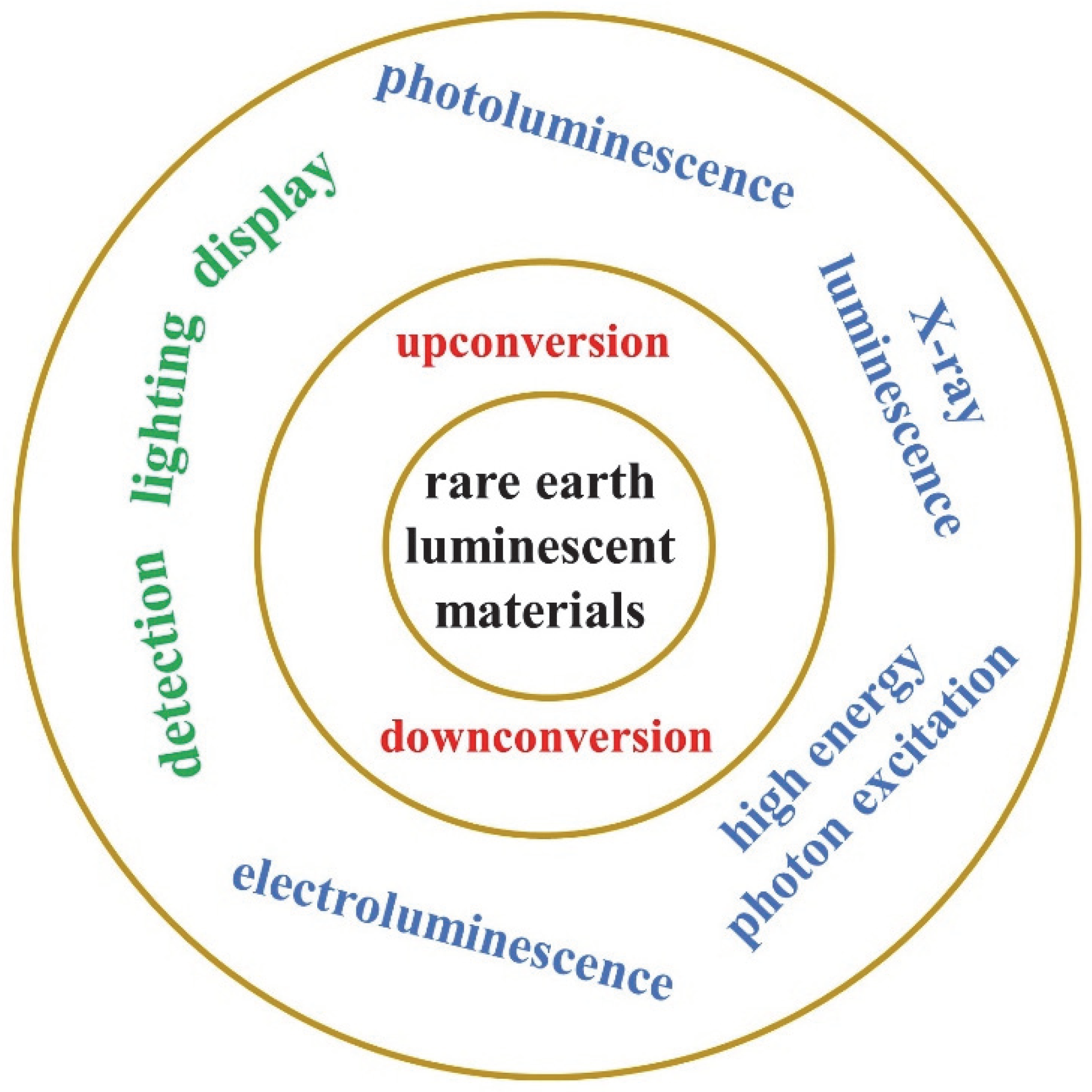
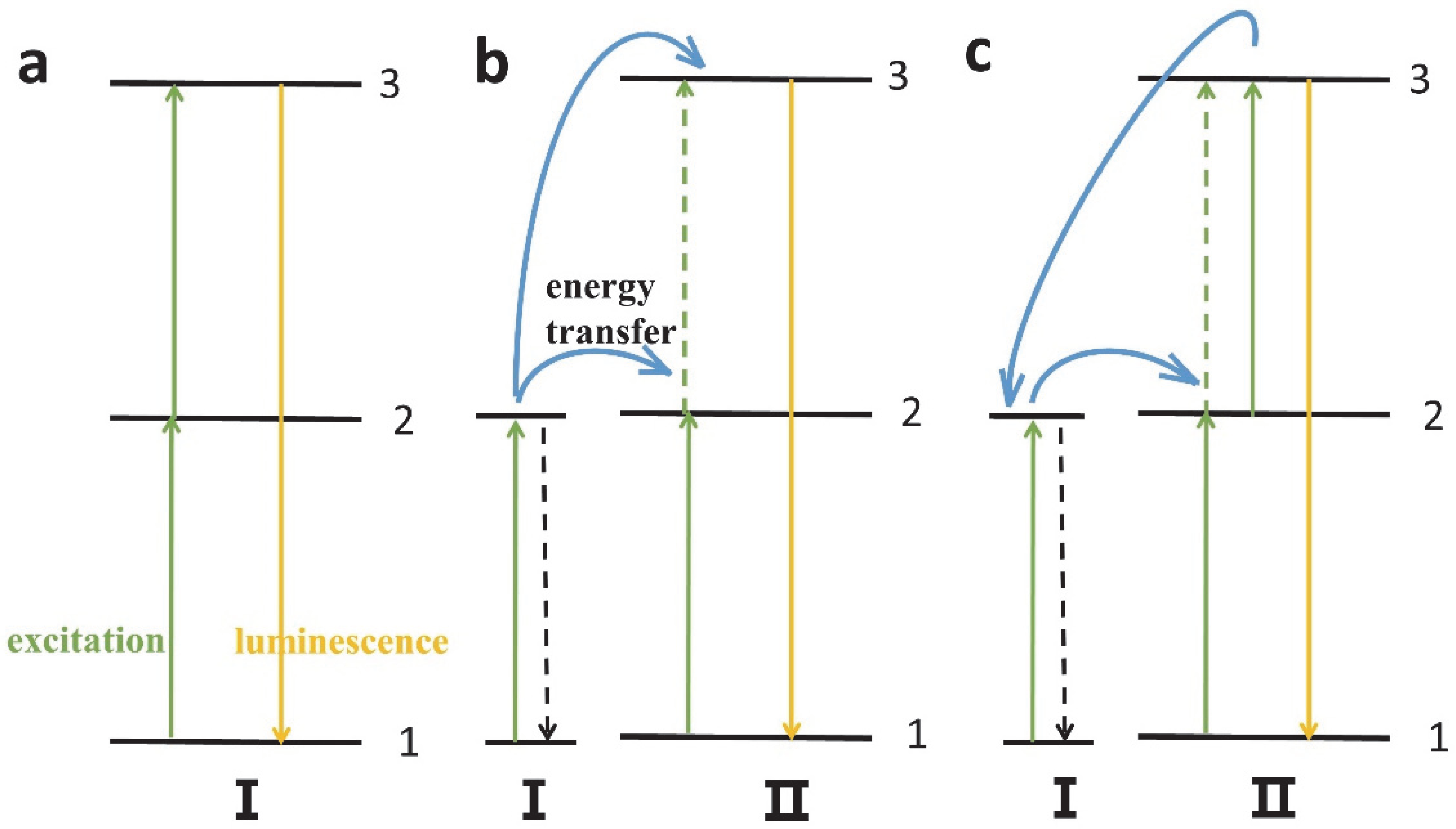
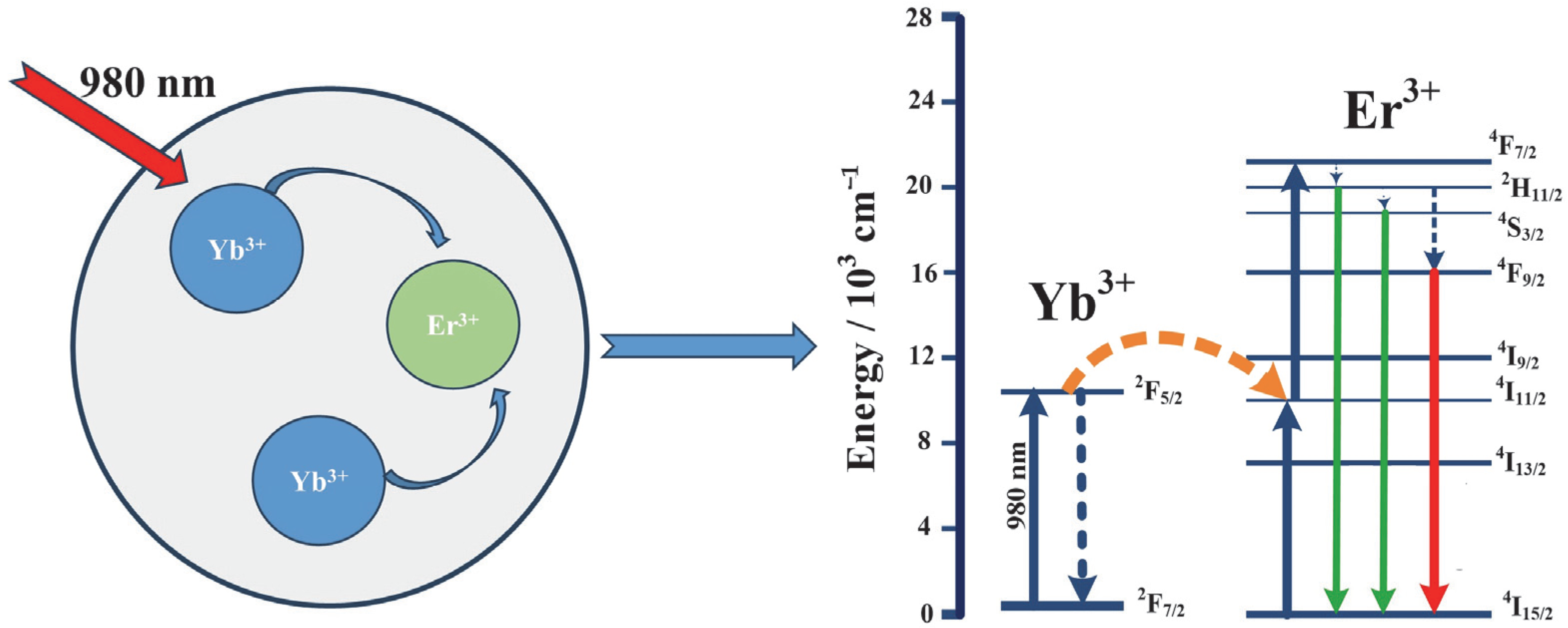

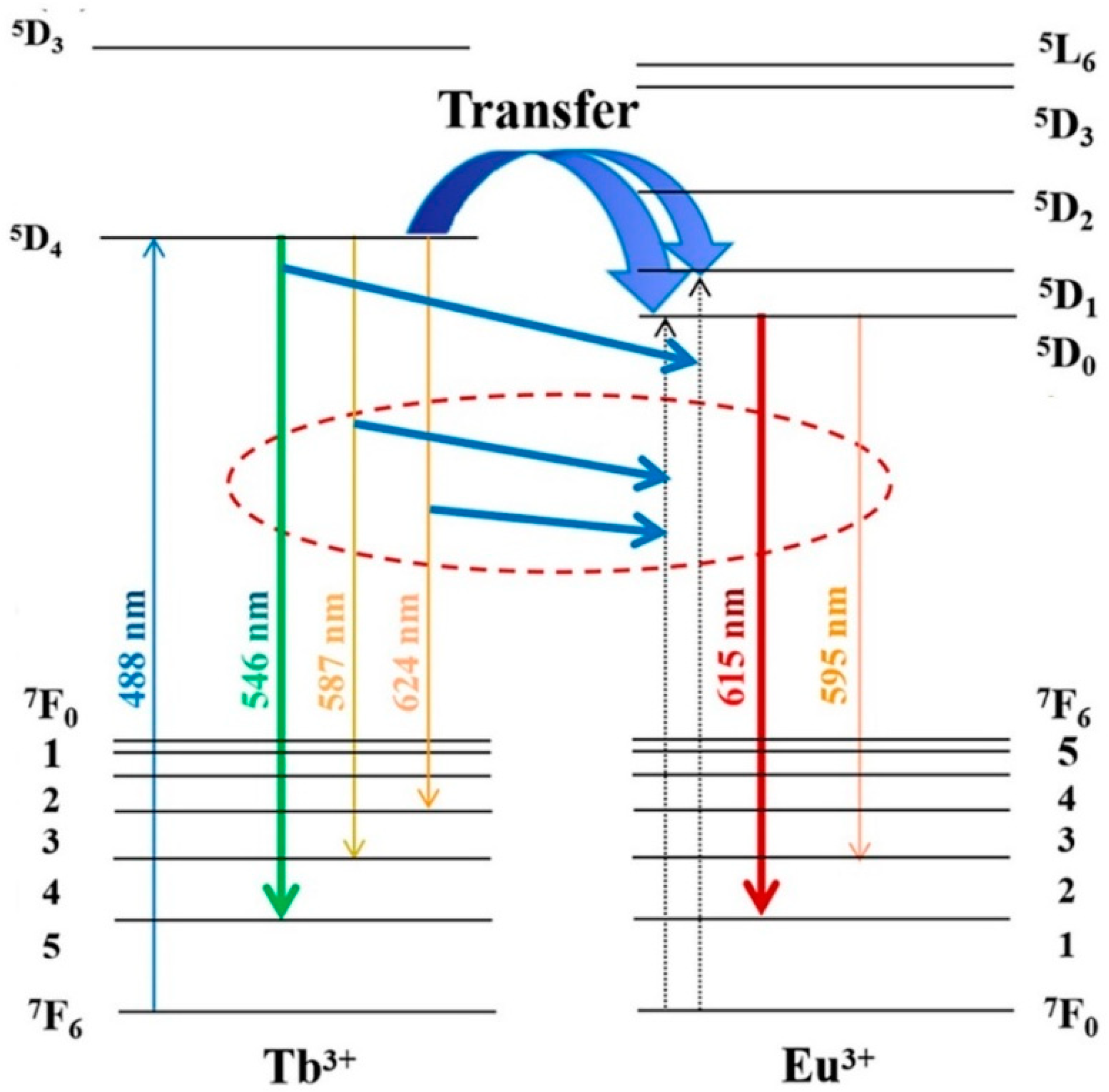
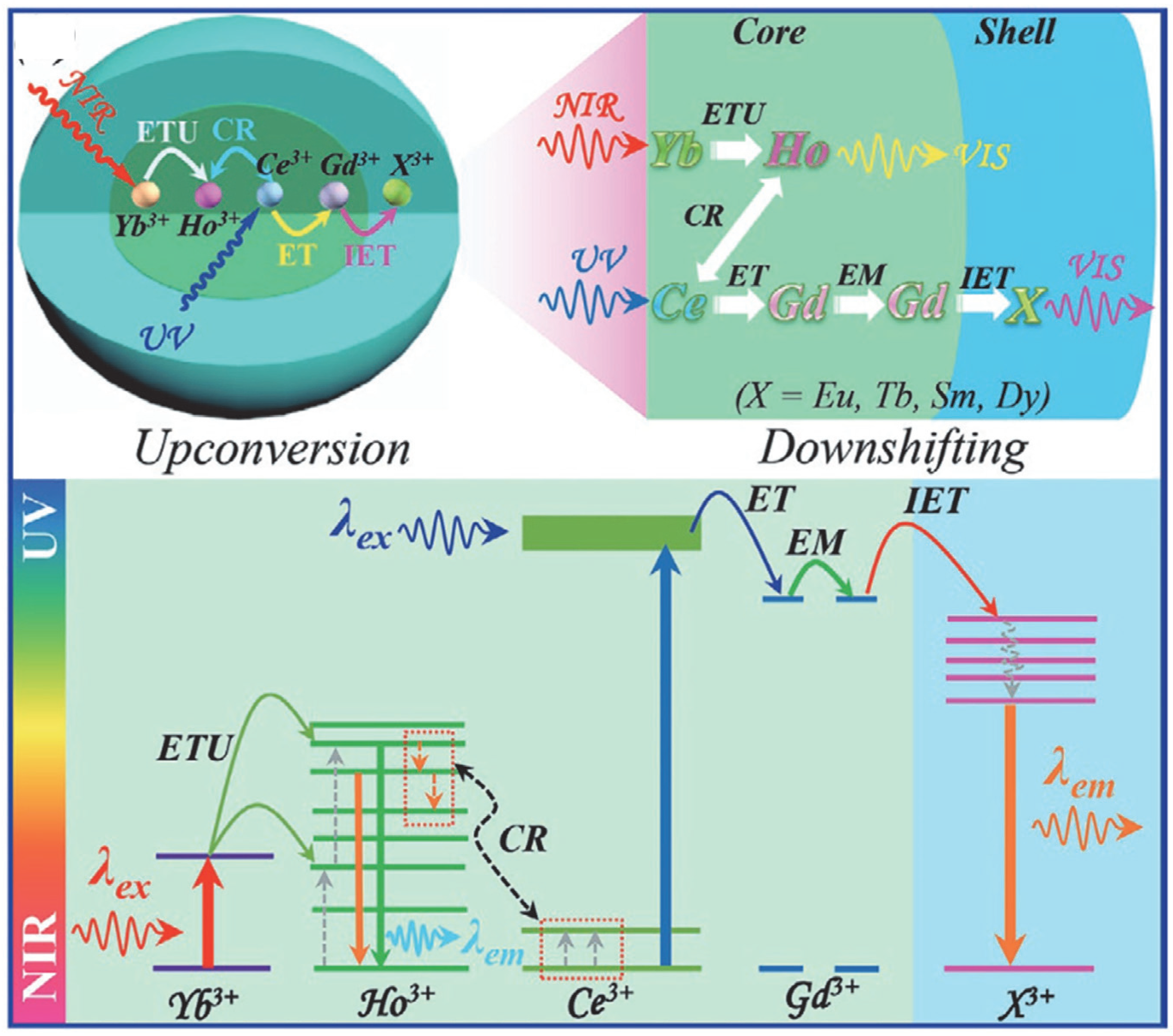

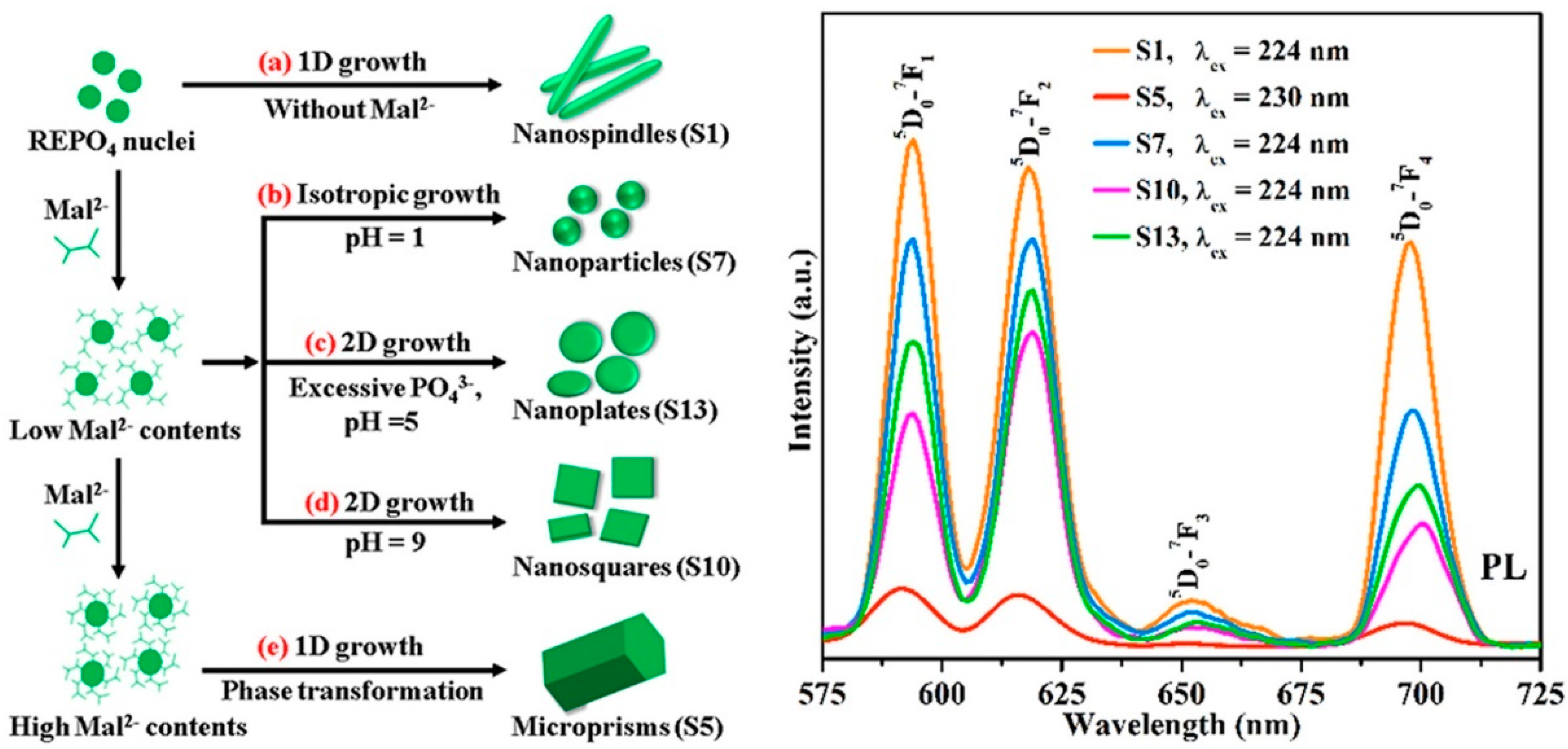

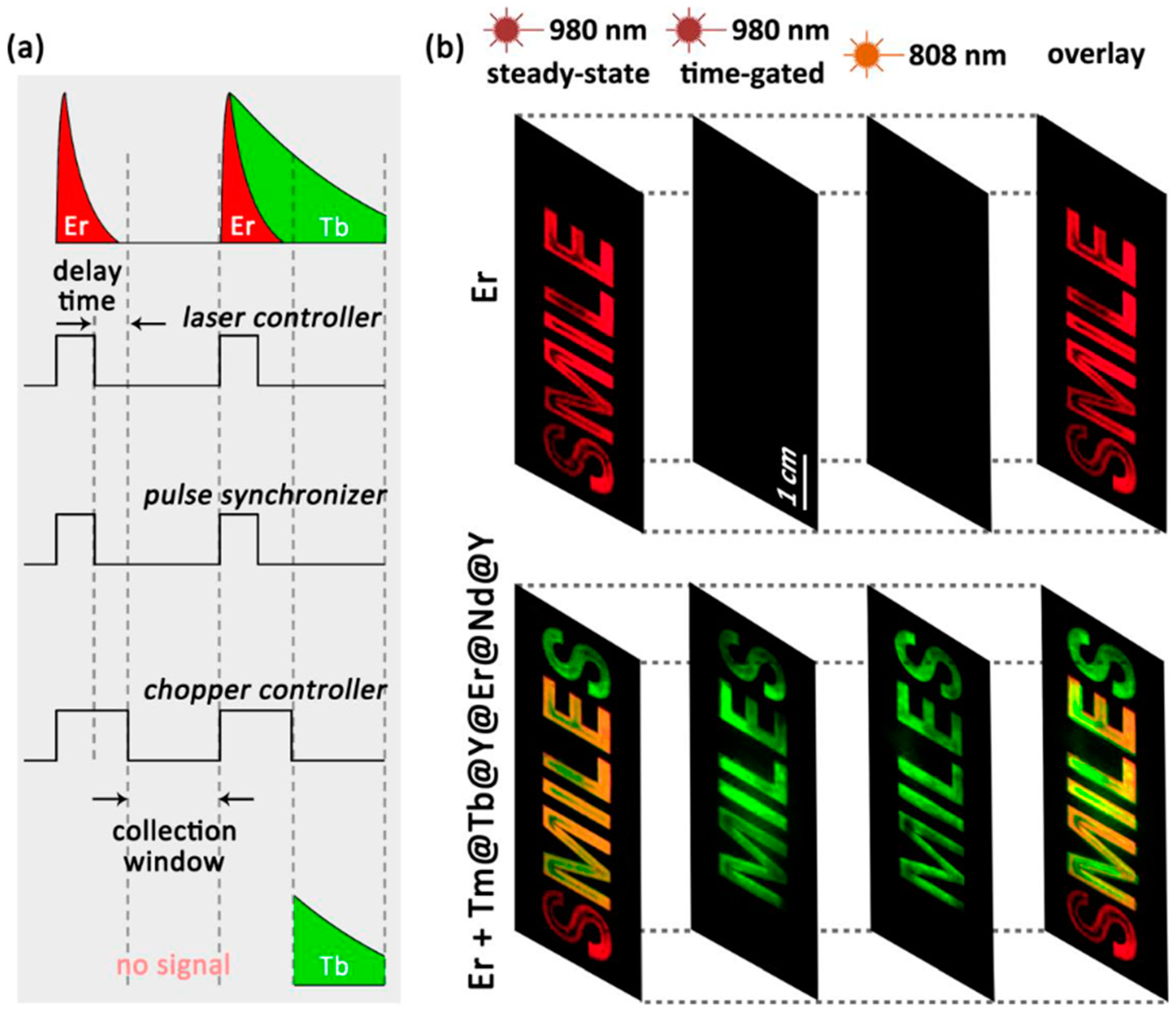
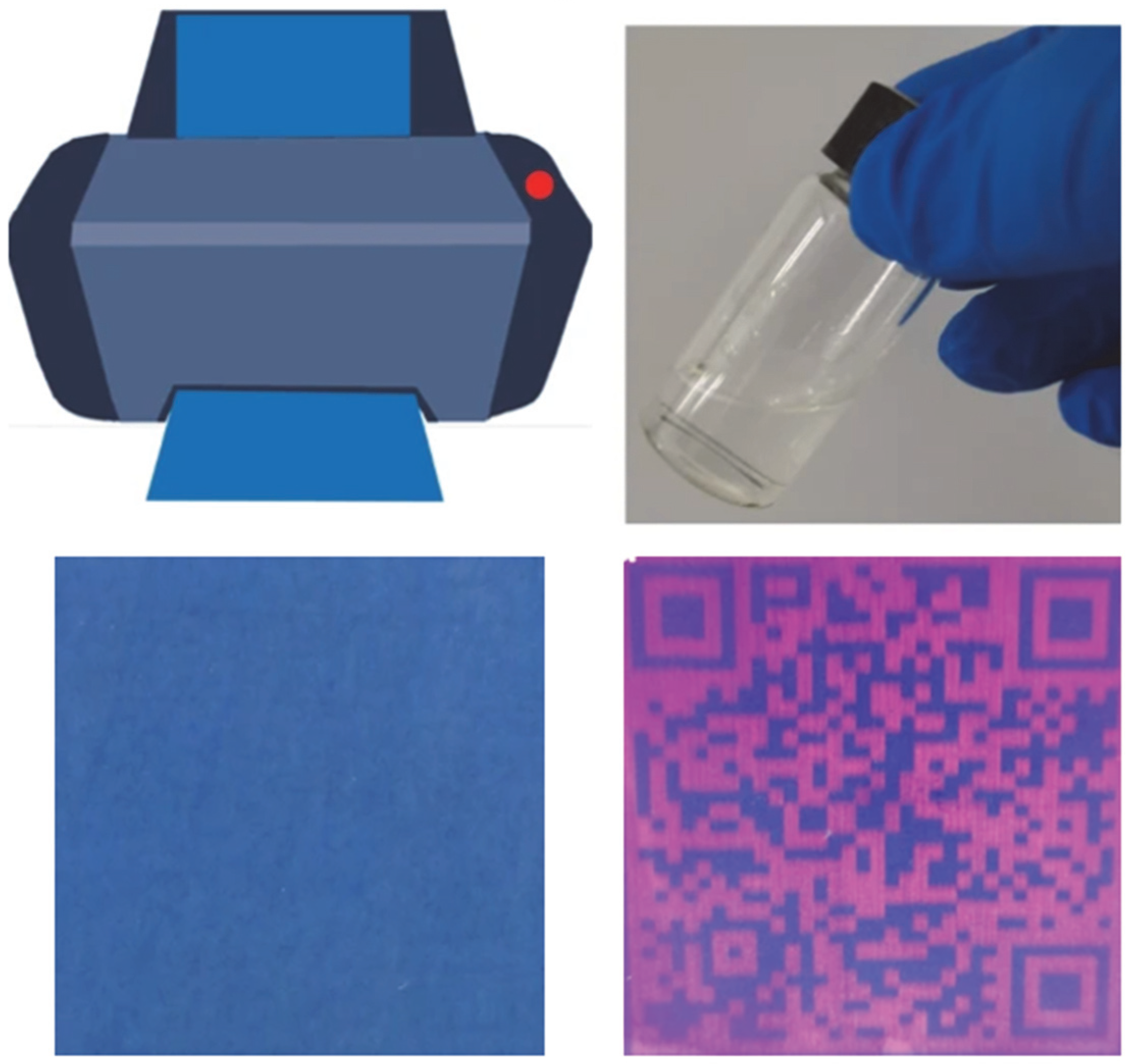
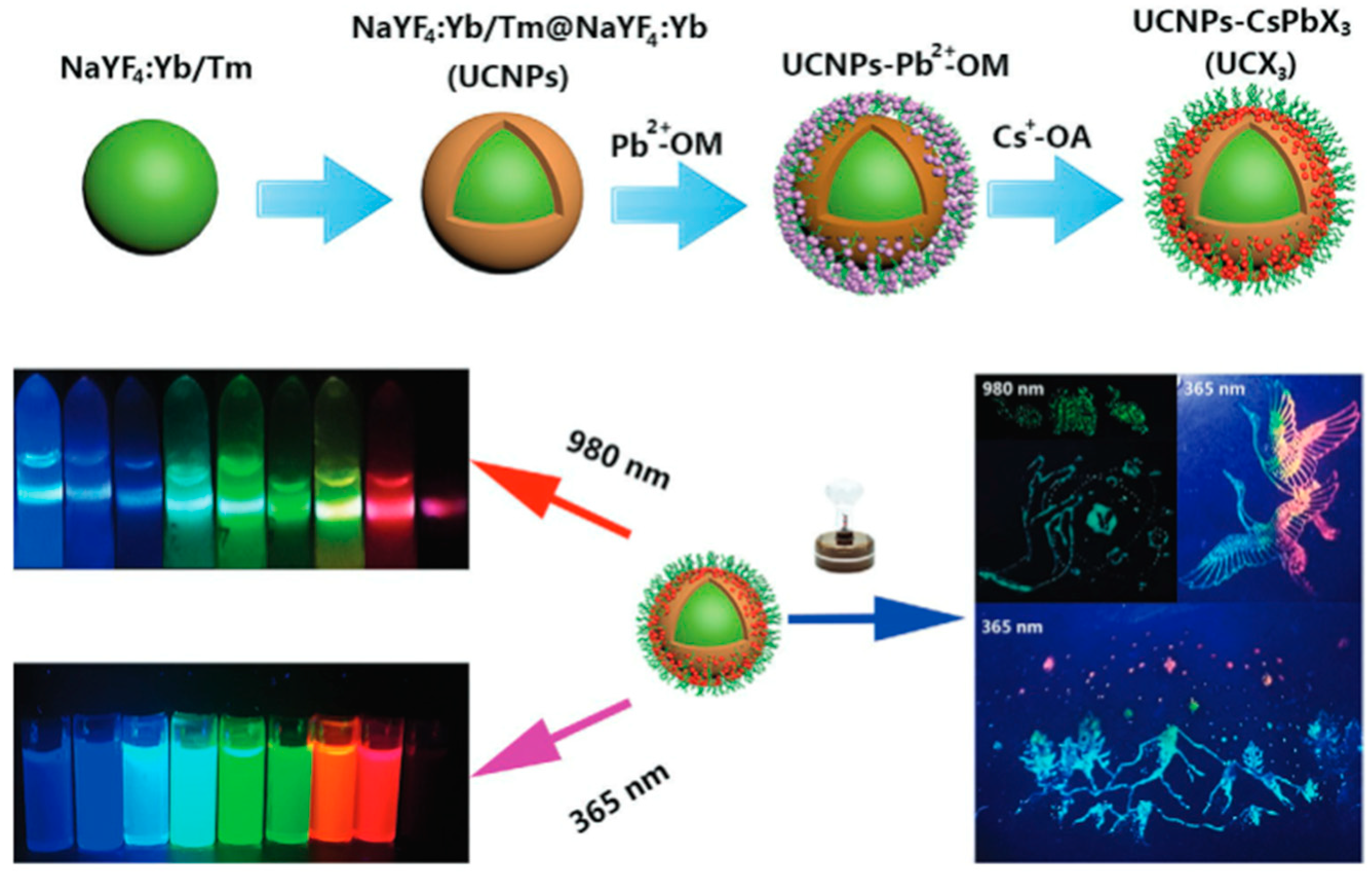
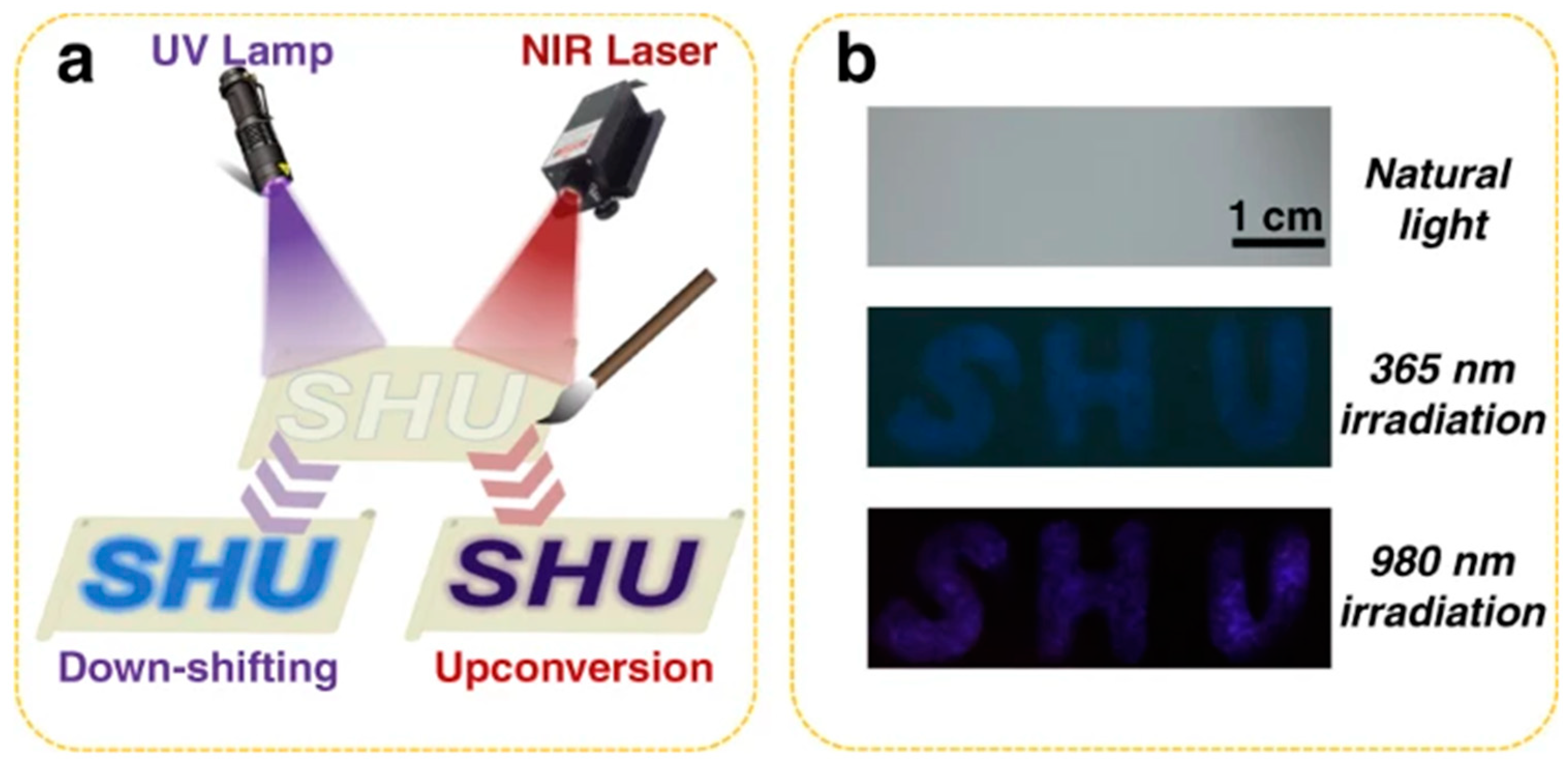
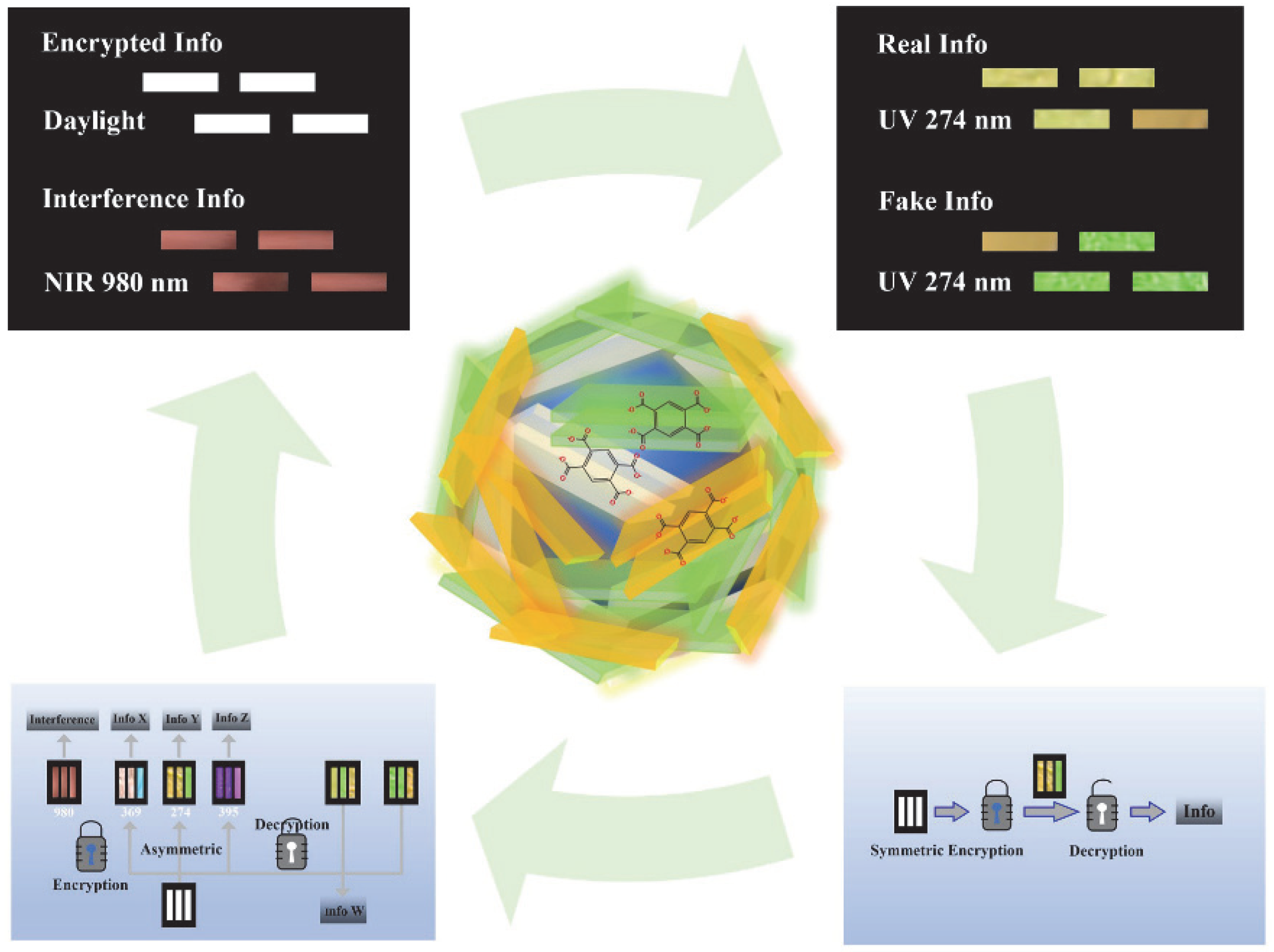
Disclaimer/Publisher’s Note: The statements, opinions and data contained in all publications are solely those of the individual author(s) and contributor(s) and not of MDPI and/or the editor(s). MDPI and/or the editor(s) disclaim responsibility for any injury to people or property resulting from any ideas, methods, instructions or products referred to in the content. |
© 2023 by the authors. Licensee MDPI, Basel, Switzerland. This article is an open access article distributed under the terms and conditions of the Creative Commons Attribution (CC BY) license (https://creativecommons.org/licenses/by/4.0/).
Share and Cite
Chen, Z.; Zhu, H.; Qian, J.; Li, Z.; Hu, X.; Guo, Y.; Fu, Y.; Zhu, H.; Nai, W.; Yang, Z.; et al. Rare Earth Ion Doped Luminescent Materials: A Review of Up/Down Conversion Luminescent Mechanism, Synthesis, and Anti-Counterfeiting Application. Photonics 2023, 10, 1014. https://doi.org/10.3390/photonics10091014
Chen Z, Zhu H, Qian J, Li Z, Hu X, Guo Y, Fu Y, Zhu H, Nai W, Yang Z, et al. Rare Earth Ion Doped Luminescent Materials: A Review of Up/Down Conversion Luminescent Mechanism, Synthesis, and Anti-Counterfeiting Application. Photonics. 2023; 10(9):1014. https://doi.org/10.3390/photonics10091014
Chicago/Turabian StyleChen, Ziyu, Hang Zhu, Jiajie Qian, Zhenxiong Li, Xiameng Hu, Yuao Guo, Yuting Fu, Huazhong Zhu, Wei Nai, Zan Yang, and et al. 2023. "Rare Earth Ion Doped Luminescent Materials: A Review of Up/Down Conversion Luminescent Mechanism, Synthesis, and Anti-Counterfeiting Application" Photonics 10, no. 9: 1014. https://doi.org/10.3390/photonics10091014
APA StyleChen, Z., Zhu, H., Qian, J., Li, Z., Hu, X., Guo, Y., Fu, Y., Zhu, H., Nai, W., Yang, Z., Li, D., & Zhou, L. (2023). Rare Earth Ion Doped Luminescent Materials: A Review of Up/Down Conversion Luminescent Mechanism, Synthesis, and Anti-Counterfeiting Application. Photonics, 10(9), 1014. https://doi.org/10.3390/photonics10091014




